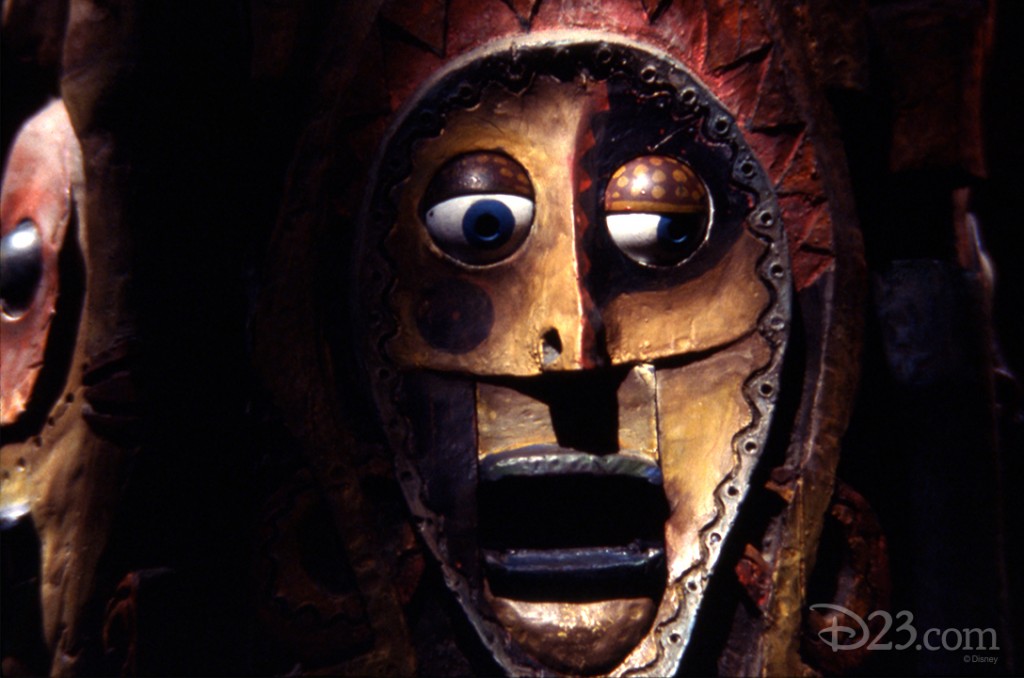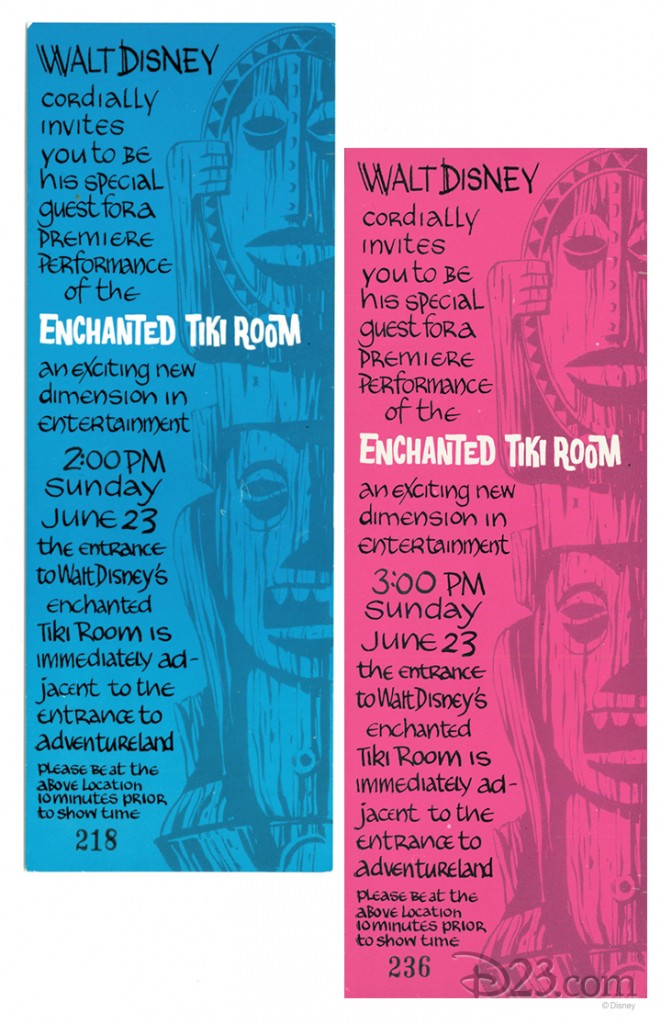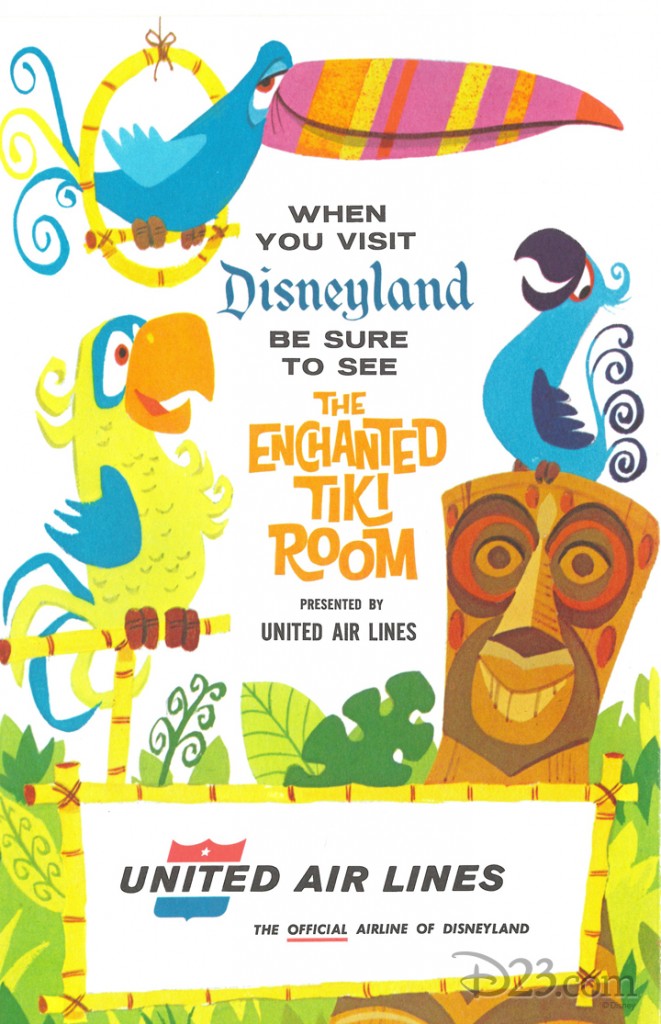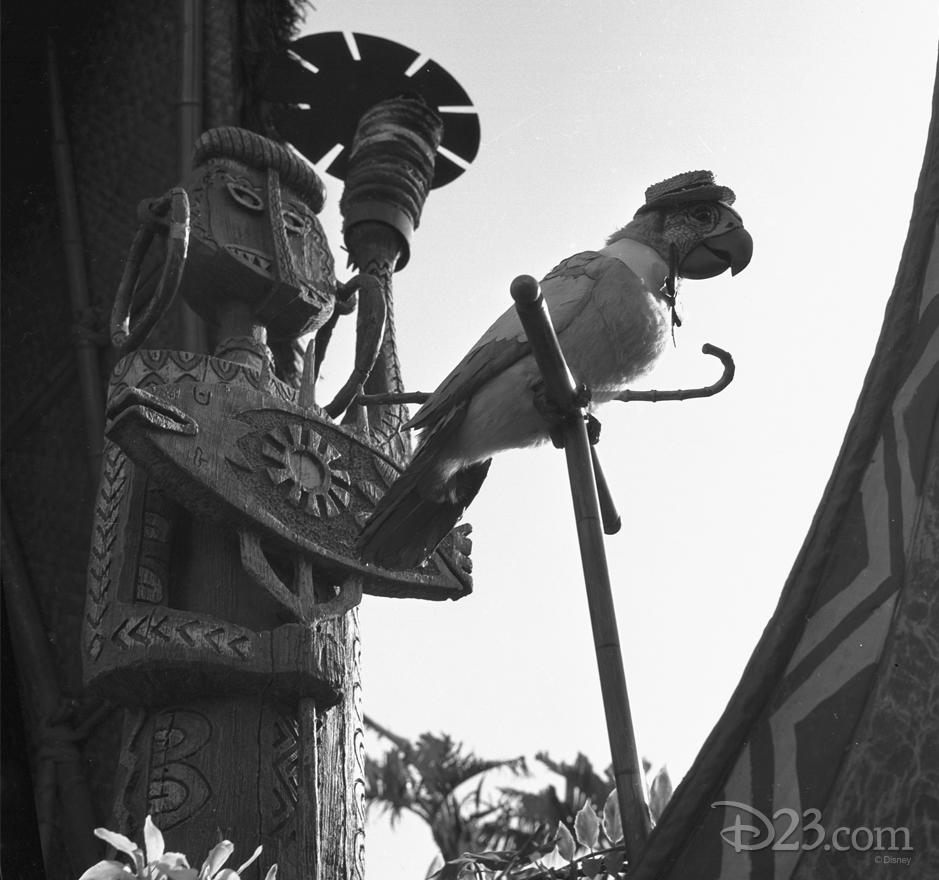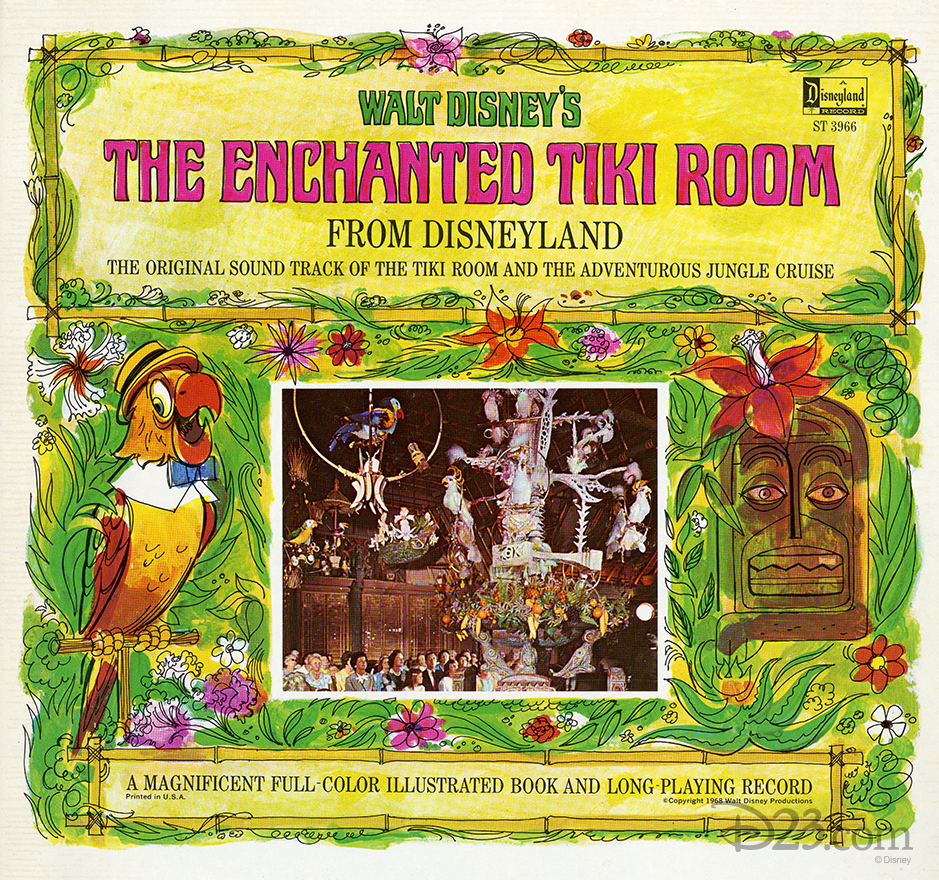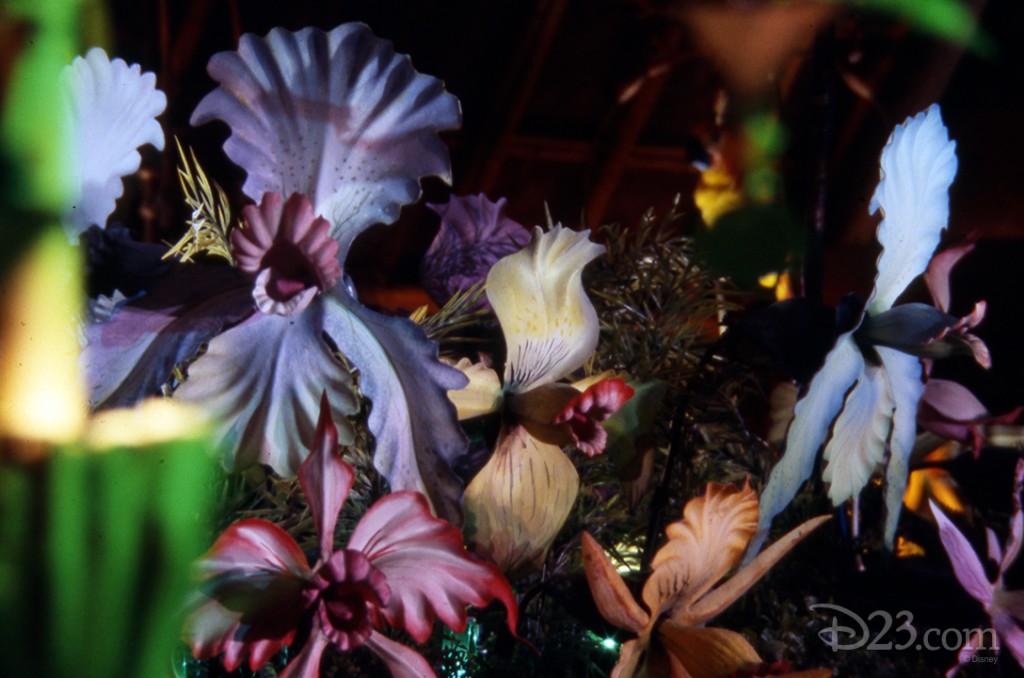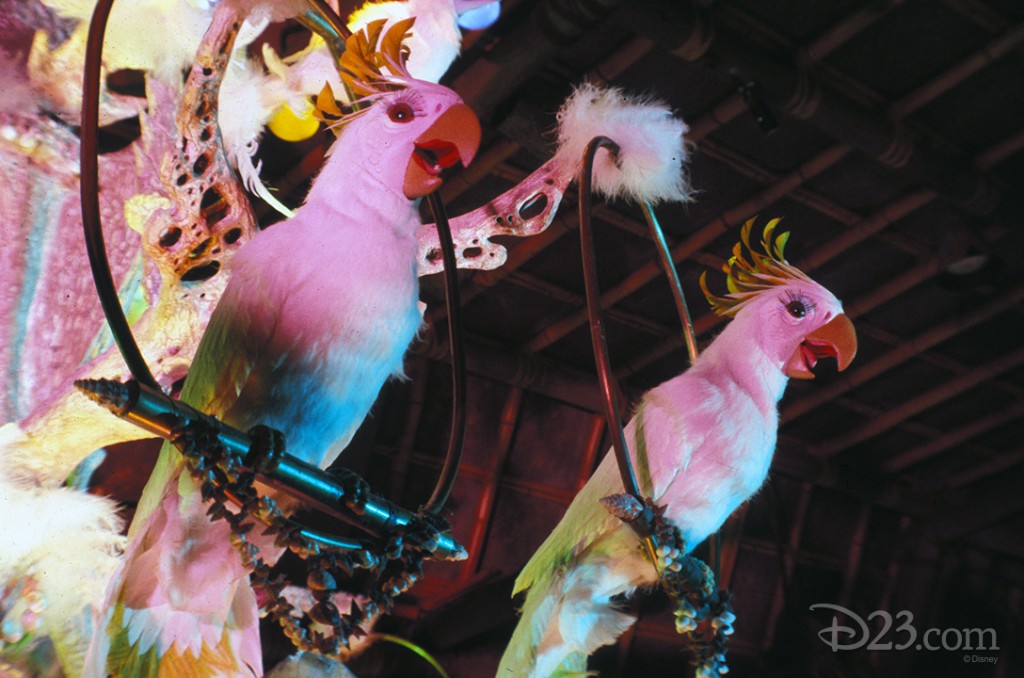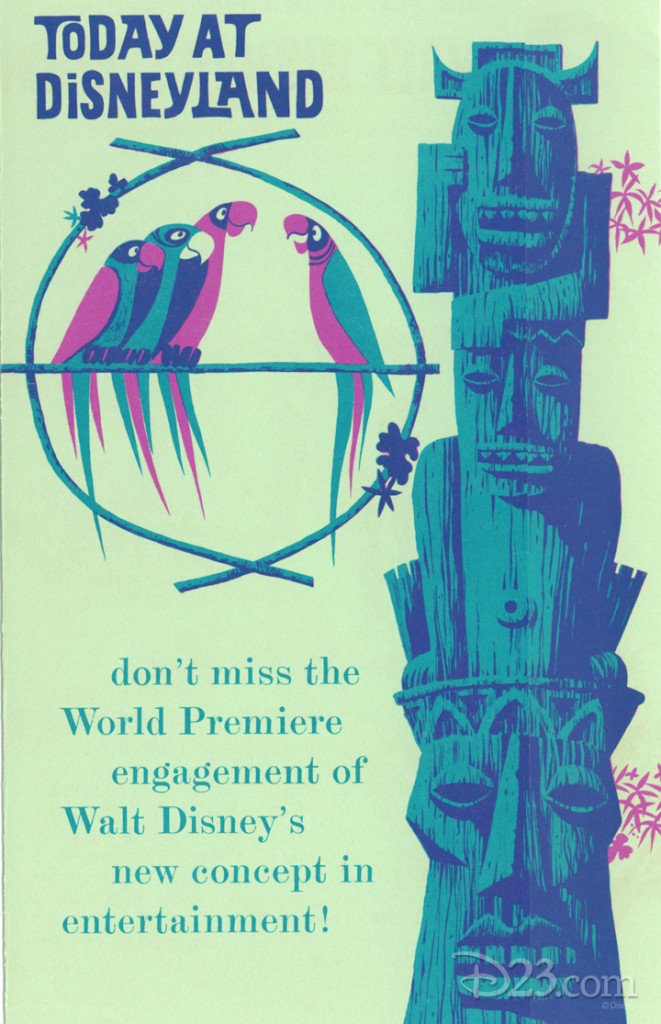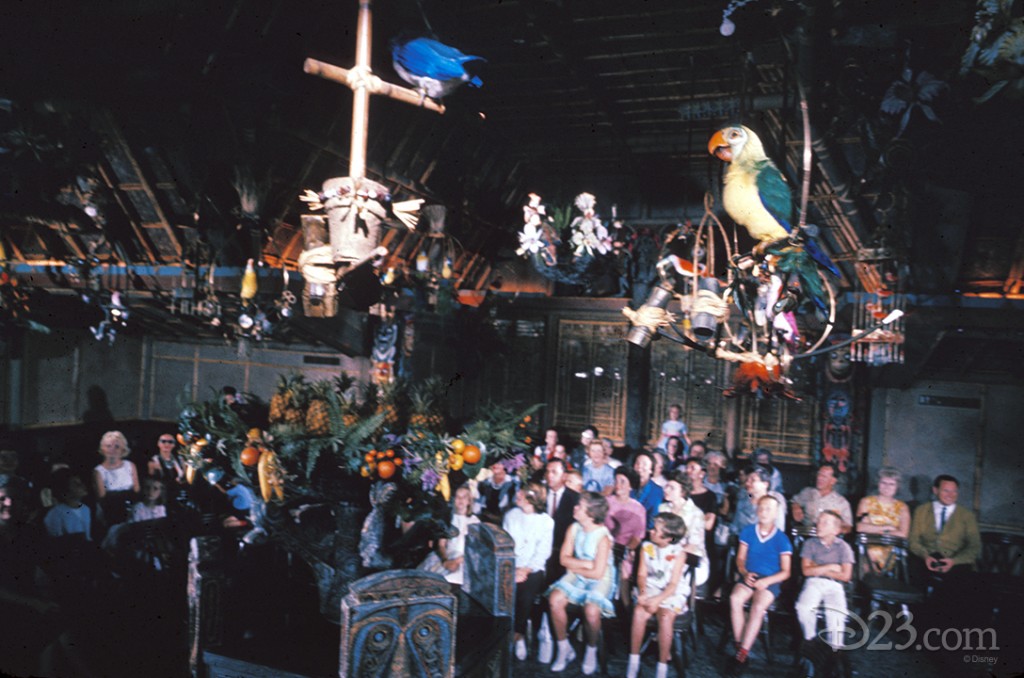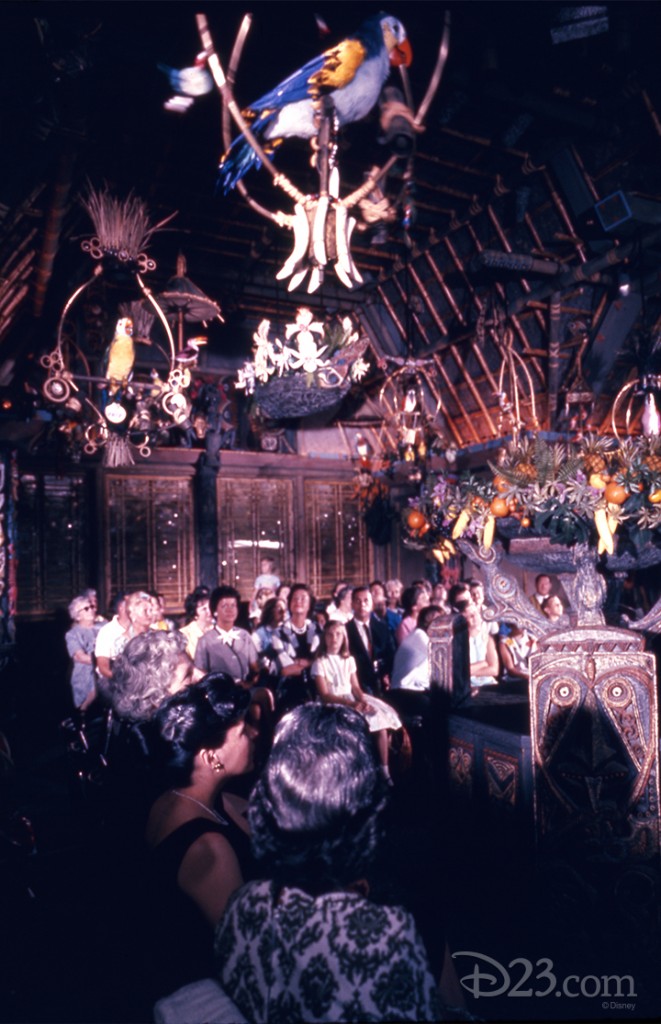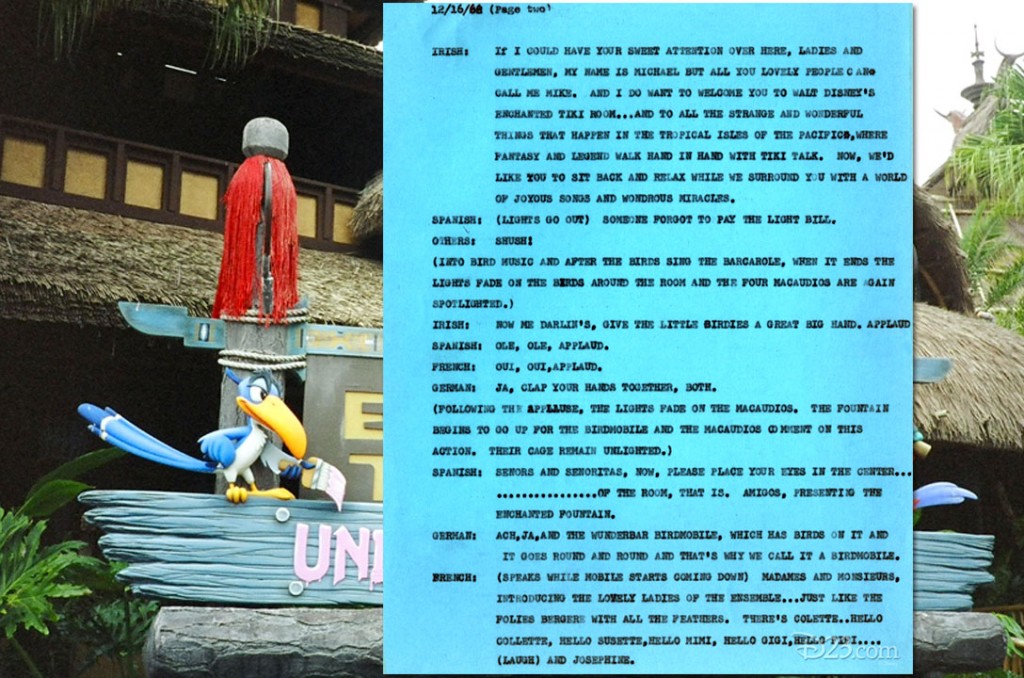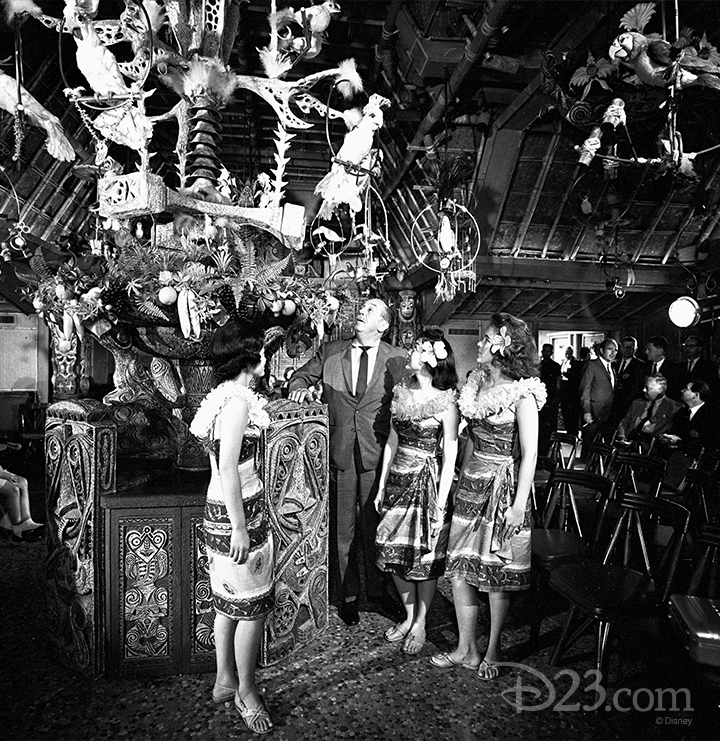By Jim Fanning
Welcome to Our Tropical Hideaway, You Lucky People, You
For 50 years of pleasure and glee, Disneyland guests have been singing (and whistling) along with the fantastic flora and fabulous fauna of Walt Disney’s Enchanted Tiki Room. Starring 225 of some of the most singular Disney characters ever created in the form of trilling birds, warbling flowers, and chanting Tiki totems, this island-inspired musical revue premiered on June 23, 1963, as the world’s first Audio- Animatronics® show. While Disneyland had always featured dimensional animated figures—for example, the animals along the Jungle Cruise—Walt wanted a more sophisticated way to infuse three-dimensional characters with convincing life while also being able to sync the animation with other figures, audio, and visual effects.
Magic is happen-ing, all the birds and flowers sing.
The golden anniversary of the Enchanted Tiki Room celebrates not only the debut of the “musical luau,” but also the birth of Disney’s Audio-Animatronics technology itself. So drift along with the tuneful trade winds as we discover the romance and music of this magical thatched-roofed theater and its enchanting inhabitants. As the Barker Bird (Who? More about him later) used to squawk, “Magic is happen-ing, all the birds and flowers sing.”
Creating the Enchantment of the Tiki Room
Walt must have had birds on the brain when he hatched the idea that was to ultimately take wing as the first Audio-Animatronics showcase. As Imagineer Wathel Rogers remembered, “It kind of started with Walt, and this little mechanical bird in a cage that he had. Walt gave it to me and asked me to look inside it.” Marveling at the movement achieved by an antiquated mechanism in the mechanical bird he found in a New Orleans curio shop, the ever inquisitive impresario asked his Imagineers if a signal could be put on magnetic tape that would make an animated bird’s mouth move. They said yes, and the Audio-Animatronics technology was on its way.
“Just as we had to learn to make our animated cartoons talk,” Walt later explained, “we had to find a way to make [the Tiki Room] characters talk, too. Now to accomplish this, we created a new type of animation, so new that we had to invent a new name for it—Audio-Animatronics. The same scientific equipment that guides rockets to the moon is used to make Jose [the macaw host] and his little friends in the Tiki Room sing, talk, move, and practically think for themselves. I guess you could call him a creature of the Space Age!” With the breakthrough of multi-channeled magnetic tape, movements like the blink of an eye or the turn of a head could be recorded alongside the soundtrack and other set cues. When the tape was played back, the “performers” gave a perfectly synchronized show every time.
Before the birds took flight as the animated Space Age pioneers, however, the attraction was originally intended to be something quite different than a swinging South Seas show. According to Disney Studio machinist Roger Broggie, Walt told his Imagineers, “I want to have a Chinese restaurant at the park. Out in the lobby will be an old Chinese fellow like Confucius—not an actor, but a figure. Now the customers will ask him questions, and he’ll reply with words of wisdom.” The restaurant was also to feature a dinner show, accompanied by an assortment of animals real and imagined, including birds and a fire-breathing, joke-telling dragon. The burgeoning Audio-Animatronics technology had a ways to go before a human figure could be convincingly portrayed—although amazingly, the ultra-sophisticated Great Moments with Mr. Lincoln was unveiled only a year after Tiki Room’s 1963 debut… so the Chinese philosopher (and the dragon) got the hook.
The birds however came home to roost. Tapping into America’s obsession with all things Tiki—interest in Polynesian culture was at an all-time high as Hawaii had just been admitted to the Union in 1959—the Imagineers morphed the Chinese dinner show into a tropical-themed “dessert” presentation starring a flock of feathered performers. On the momentous date of October 9, 1963, however, the decision was made to drop the dinner and keep the show as Walt realized diners, mesmerized by the avian entertainers, wouldn’t leave the restaurant in time for the next performance—and so the show intended to be seen during dessert became the main course.
In creating the colorful cast for this show that would now be an attraction in its own right, Walt said to his designers, “This show doesn’t have to be a natural history museum. Let’s have some fun!” Imagineer Rolly Crump’s first designs were stylized, but Walt thought they were a little “too crazy.” Sculptor Blaine Gibson then produced a more naturalistic bird shape in clay, adding a touch of Disney personality to the face. “Walt didn’t want an absolutely realistic parrot,” Blaine remembered, “but one with a little bit of cheek on it, something you could get some expression out of.” Legendary Disney artist Marc Davis (whose first Imagineering assignment this was) designed whimsical birds and flowers with human-like personalities. Not so coincidentally, Marc was a collector of authentic oceanic art, and he incorporated many genuine details and patterns into his drawings. “I knew what I was looking for.” Marc recalled, “I designed those ‘talking totems,’ and all those things that came to life there.”
Imagineer Harriet Burns designed and feathered many of the Enchanted Tiki Room birds, using real feathers. “I want these birds to be so real you can see them breathe,” Walt told her. A breathtaking assignment, but Harriet developed a way to add a stretch-and-recover aspect to the figures’ chest covering, an inspiration based on her observation of the way the blue wool sweater Walt liked to wear moved at the elbows.
A Song in the Key of Tiki
As a test, the “Legends of the Enchanted Tiki” (the working title of the attraction) was mocked up in Stage 2 at the Disney Studio. Walt invited his virtuoso tunesmiths, the Sherman Brothers, to view the show. (Richard speculated that the hit song “Pineapple Princess” that he and his brother Robert wrote for Annette in 1960 is probably what made Walt think of the Shermans when it came time for a Tiki song.) When he asked the songwriting siblings if they had any ideas, they recalled a calypso song they had composed for a Disney TV show about the production of Swiss Family Robinson (1960). “So,” recalled the Shermans, “we suggested that the song could be done in a calypso beat: ‘the Tiki, Tiki, Tiki, Tiki, Tiki Room.’ It had a sound you could remember. And Walt bought the idea, just like that. We wrote the lengthy, gag-filled calypso ‘Tiki Room’ song, which performs the all-important task of explaining to the audience what they are about to see and hear.”
Instead of one parrot emcee, we’ll have four, with French, Spanish, German. and Irish accents.
“The Tiki Tiki Tiki Room” not only gave the show a focus, it also gave it a name. Additionally, the four famous spokesbirds had yet to be designed. To add a sense of continuity to the show, Richard and Robert suggested that a colorful parrot with a personality serve as emcee. Walt liked the idea so much, he built on their inspiration. “Instead of one parrot emcee, we’ll have four, with French, Spanish, German. and Irish accents.” As the Shermans noted, “Walt always had a way of plussing a good idea.” With the cast firmly in place—and with more jokes and birdbrained fun contributed by writers Larry Clemmons and Marty Sklar, as well as Wally Boag and Fulton Burley—the Enchanted Tiki Room was ready to fly.
Meet the “MacAudios”
The four parrot hosts evolved into everyone’s favorite flighty macaws, amusingly dubbed “the MacAudios.” First among the feathered equals is José, the Spanish-accented amigo, voiced by legendary Disneyland performer Wally Boag. Wally’s Golden Horseshoe Revue co-star Fulton Burley voices Michael, the Irish-brogued bird (his moniker was originally to be Paddy), while Fritz booms with a Bavarian baritone provided by legendary voice artist Thurl Ravenscroft, well-known as Uncle Theodore, the lead singing bust in the Haunted Mansion. Ernie Newton, the vocal artist behind the singing knight in the Haunted Mansion, voices the French-accented MacAudio, Pierre.
Originally, the plumage of the talkative Tiki Room headliners was colored to correspond with their national flags. Though the feathers’ hues were modified over the years, today each emcee has vivid, visually distinct colors that reflect that original design concept: Jose has a red crest and a green body; Michael is white with green head and wings; Fritz is burnt orange and white; and Pierre is red, white, and blue. Besides the four hovering hosts, the revue also features an additional four macaws, six cockatoos, nearly 30 tropical birds, 12 toucans, more than 50 orchids, seven bird-of-paradise flowers, 12 Tiki drummers, and singing Tiki war god totems.
Walt usually knew what he wanted, and these birdie beauties were no exception
The “Birdmobile,” which lowers from the room’s ceiling, is the revolving showcase for the six Folies Bergère-style showgirl cockatoos. As can be seen from their nameplates just below their personalized perches, each of these birdie beauties has a name: Collette, Suzette, Mimi, Gigi, Fifi, and Josephine. (“I wonder what happened to Rosita?”) Walt usually knew what he wanted, and these birdie beauties were no exception: He insisted that they sing not with bird-like tweets but with human voices—specifically in the style of Peruvian purveyor of exotica music, Yma Sumac. Rolly Crump sculpted the chandelier-like Birdmobile where it now hangs, sitting atop a ladder to carve the contraption in the middle of the Tiki room.
At The Gateway To Adventureland
One of the most incredible aspects of Walt Disney’s Enchanted Tiki Room is that, once the show was written and recorded, the Imagineers had the show up and running in Adventureland in a mere three months. Surprisingly, the first public performance of José and his blossomed-and-beaked Tiki troupe was not at Disneyland but at the Disney Studio, where, on April 10, 1963, invited members of the press saw a preview on Stage 3. On June 19, Walt hosted an official press preview of his Audio-Animatronics aviary for reporters from more than 40 major newspapers, magazines, and TV and radio stations. Finally, the doors of the magical theatre-in-the-round—designed in the style of the assembly lodges and communal houses once found throughout the South Seas—opened to all Disneyland guests on June 23.
For a while after the groundbreaking attraction officially opened, Enchanted Tiki Room boasted an Audio-Animatronics Barker Bird outside the attraction’s entryway to attract guests like a carnival midway pitchman. Also known as the Tiki Room Ballyhoo Parrot, this big-beaked barker was Juan, the cousin of MacAudio José (although he was just as often referred to as José), as Walt did when he featured the barker on the “Disneyland 10th Anniversary” episode of Walt Disney’s Wonderful World of Color. The spectacle of this animated, talking bird caused traffic jams along the Adventureland walkway as guests gathered to enjoy this wisecracking macaw.
Walt Disney’s Enchanted Tiki Room . . . is Disney entertainment at its most exciting, best kind.
Eventually Juan was retired. Here’s a sampling of Juan’s appealing spiel: “Amigos, Romans, and Disneylanders! Stop walking while I’m squawking. Walt Disney’s Enchanted Tiki Room . . . is Disney entertainment at its most exciting, best kind.” And, he continued, since the show “is on the inside, not the outside—that would be silly,” and Juan invited guests to come in “and sit down on your feathered dusters. Those amazing birds sing. They chant. They whistle. They croon.” Then, after singing a few bars, the Barker Bird cracked, “What did you expect? The Vienna Boys Choir?”
“Where Fantasy and Legend Walk Hand in Hand with Tiki Talk”
One enchanting element of this Adventureland favorite enjoyed by “early birdies” waiting to see José and the rest of the colorful cast take wing is the Enchanted Tiki Garden. The idea of placing tiki figures in the restful outdoor landscaping to “set the mood for guests before the show begins” came from Imagineering legend John Hench. “In this Tropical Paradise Legendary Gods and Goddesses of the Islands Guard Portals to Walt Disney’s Enchanted Tiki Room,” reads a sign carved and painted in a style recalling the bold graphic designs of New Guinea.
The Tiki gods were designed by Imagineer Collin Campbell and sculpted by Rolly Crump — with the “tiki talk” written by Imagineering great Marty Sklar.
The Tiki gods were designed by Imagineer Collin Campbell and sculpted by Rolly Crump—who researched Pacific island mythology for the speaking statuary—with the “tiki talk” written by Imagineering great Marty Sklar. The garden’s gods and goddesses were vocalized by deep-voiced Thurl Ravenscroft who voiced Fritz and spoke for the “mighty tree” Tangaroa; Hina (goddess of rain) was Disney Studio veteran Anne Essex; Ginny Tyler, voice of the lovesick girl squirrel in The Sword in the Stone (1963) portrayed both Pele and Tangaroa-Ru (the east wind); and Hawaiian-born musician Ernie Tavares provided voices for the remaining four deities: clock-faced Maui, Koro (the midnight dancer), Ngendi (the earth balancer), and Rongo (the kite-flyer). In addition, Tavares chanted in Hawaiian for the tiki totems inside, and is the voice that invites waiting visitors to come inside as the doors to the Enchanted Tiki Room open.
More Tunes That Are Crooned
Under the direction of Disney’s veteran conductor and arranger George Bruns, the Tiki Room’s dialog and singing (to say nothing of the whistling) was recorded at the Disney Studios in February 1963. The eclectic cast that provided the exotic bird calls and whistling included Clarence “Ducky” Nash (the original voice of Donald Duck), band singer and orchestra leader (on Art Linkletter’s House Party TV show) Maurice “Muzzy” Marcelino, Marion Darlington (who had warbled for the birds in Snow White and the Seven Dwarfs)—and best of all, novelty vocalist A. Purvis Pullen, also known as Dr. Horatio Q. Birdbath (yes, really), a real-life ornithologist and replicator of more than 900 bird sounds. Vocalists included George Bruns’ wife Jeanne Gayle and Betty Wand (who sang “Baby Mine” in Walt Disney’s Dumbo, 1941).
Let’s All Sing Like the Birdies Sing
In addition to the unforgettably catchy theme song by the Sherman Brothers, the Tiki Room show incorporates other tunes for the guests to warble like nightingales. José jokingly describes “Let’s All Sing Like the Birdies Sing” as “our national anthem.” During the performance of this singalong standard, Fritz imitates Louis Armstrong, José croons in the style of Bing Crosby (the Crosby-esque boo-boo-booing was performed by famed Hollywood voice-double Bill Lee, who sang “Cruella De Vil” in One Hundred and One Dalmatians, 1961) and Pierre musically mimics Maurice Chevalier. The famed “Hawaiian War Chant” is sung with the original Hawaiian lyrics, and the “Closing Bows/Drums” number is by Jimmie Dodd, the head Mouseketeer on Walt Disney’s Mickey Mouse Club TV series. As the audience leaves—after José’s pointed suggestion that the audience give the Tiki Room performers a standing ovation—an unseen chorus sings an upbeat exit song to the melody of “Heigh-Ho” from Snow White and the Seven Dwarfs, with new lyrics by Wally Boag (and a few gags suggested by other members of the team).
All of the songs—in fact, the soundtrack of the entire attraction—was included on the Enchanted Tiki Room record album released in 1968 on the Disneyland Records label. The specially commissioned album art was by veteran Disney artist Pete Alvarado, under the pseudonym of Bart Doe.
Care and Feeding of the Flowers and Feathers
For five decades, cast members entrusted with maintaining this classic Disneyland attraction have treated the avian actors and horticultural performers with TLC. According to a 1988 report, each of the birds is meticulously examined and dusted every week. About 40 hours is needed to replace just one feather, and the bird figures are re-feathered by professional taxidermists. The white-plumed Birdmobile Girls are exchanged with their doubles every six months to ensure the pristine color of their ever-fashionable feather ’dos.
50 years of flowers, feathers, and fun
In 2004, this beloved attraction received an extensive refurbishment. The feathered and flowered friends as well as all the remarkable residents of the Tiki Room were meticulously restored to their original pristine condition, including a mechanical makeover of the internal components for each of the Audio-Animatronics stars. In 2005, Imagineers discovered the original source tapes in the audio vault and painstakingly restored the Tiki Room soundtrack, while also installing new speakers and audio equipment, resulting in sound with greater clarity than the original. As it celebrates 50 years of flowers, feathers, and fun, Walt Disney’s Enchanted Tiki Room is, more than ever, “a world of joyous song and wondrous miracles.”



